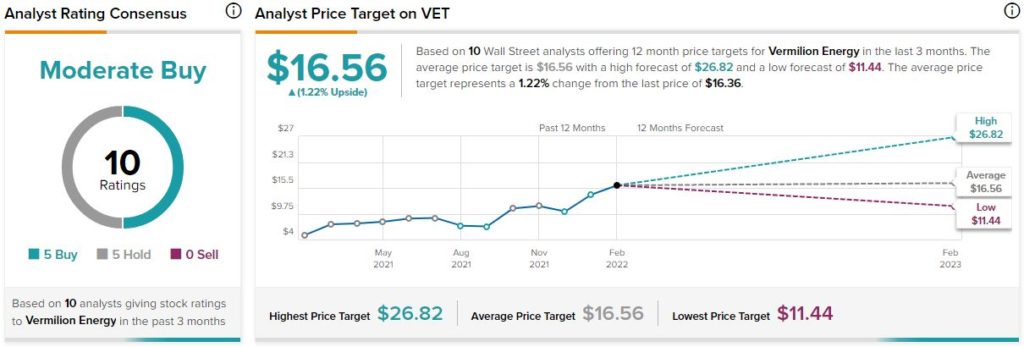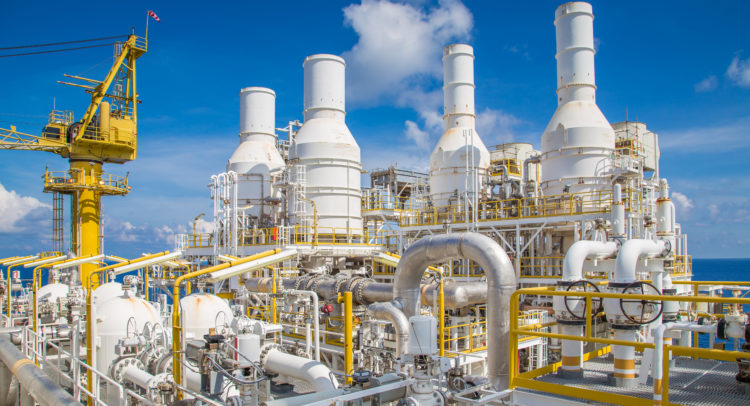Vermilion Energy, Inc. (VET) engages in the acquisition, exploration, development, and production of oil and natural gas. It operates through the following segments: Australia, Canada, France, Ireland, Germany, the United States of America, the Netherlands, and Corporate. The company was founded in 1994 and is headquartered in Calgary, Canada.
Shares of Vermilion Energy have gains of about 235% in the past year and almost 30% year-to-date. I am bearish on VET stock as the company has a high level of debt (although it has been reducing it) and poor financial strength.
The rally in commodities, especially crude oil and natural gas, may come to an end at the end of the winter, adding pressure to profitability. The stock is trading near 52-week highs, making a correction to lower stock price levels highly likely.
Vermilion Energy Financial Risks
Due to the nature of its business, Vermilion Energy is exposed to several risks that are associated with financial instruments. These financial risks include market risks such as commodity price risk, interest rate risk, currency risk, credit risk, and liquidity risk.
Vermilion is exposed to commodity price risk on its derivative assets and liabilities, being part of the company’s risk management program to mitigate the effects of changes in commodity prices on future cash flows. The company is hedging these risks partially, and changes in commodity prices strongly impact the fair value of derivative instruments and the corresponding gains or losses recognized on derivative instruments.
Vermilion is exposed to currency risk on its financial instruments denominated in foreign currencies. Notably, currency risk includes cash and cash equivalents, accounts receivables, payables, lease obligations, long-term debt, derivative assets, and liabilities.
Most of these financial instruments are primarily denominated in the U.S. dollar and the Euro, and Vermilion is frequently checking whether it is prudent to use derivative financial instruments to mitigate fluctuations in foreign exchange rates.
Interest rate risk is related to revolving credit facilities, which are short-term borrowing instruments that bear interest at market rates. Higher interest rates are expected to increase the costs that Vermilion must pay. The company already has a high level of debt.
Credit risk is about the number of accounts receivable the company is to receive from its customers. This risk is not negligible. For example, back in late 2020, VET had exposure to the receivable credit risk of $215.5 million (Canadian Dollars).
Finally, there is the liquidity risk, the inability of the company to pay its short-term obligations on time. As per the latest quarter, Vermilion has a current ratio of 0.51 and a quick ratio of 0.31. I, therefore, see the main reason of concern related to liquidity now.
Latest Earnings and Fundamentals, Risks
VET stock earnings do not show any significant trend and are highly volatile. In Q3 2021, the reported EPS of -$0.72 was a miss compared to the estimate of $0.30.
Vermilion reported a loss of C$147.13 million, stating, “the increase in net loss was primarily driven by unrealized losses on derivatives due to increased commodity prices. These losses were partially offset by an increase in FFO which was predominantly driven by an increase in realized pricing, as well as a decrease in impairment reversals recognized versus the prior quarter.”
Derivatives can provide financial protection and mitigate losses, but they can also lead to massive losses due to their financial leverage. The company is also presenting a weakness in efficiency as its fixed assets turnover and asset turnover ratios have both declined over the past two consecutive years.
Other warnings signs are Vermilion Energy’s revenue, which is still not above 2019 levels, and the Altman Z-score of 1.4, which is in the “gray zone.” This is close to the “distress zone,” which would imply bankruptcy risk within two years.
Valuation
VET stock is relatively attractive based on its P/E ratio of 4.5x compared to the U.S. oil & gas industry average of 18.1x and based on its price/book ratio of 1.9x compared to the U.S. oil & gas industry average of 2.1x.
Wall Street’s Take
Vermilion has a Moderate Buy consensus rating based on five Buys and five Hold ratings. The average Vermilion Energy price target of $16.56 represents 1.2% upside potential.

Conclusion
Vermilion has surged in the past year and has started 2022 with solid gains. The company still has a lot of debt, although it has decreased it and has reported a net loss in Q3 2021 due to financial derivatives related to commodity prices. An end of the soaring energy prices rally in 2022 could be a big challenge for the firm to have sustainable profitability.
Download the TipRanks mobile app now
To find good ideas for stocks trading at attractive valuations, visit TipRanks’ Best Stocks to Buy, a newly launched tool that unites all of TipRanks’ equity insights.
Read full Disclaimer & Disclosure
















